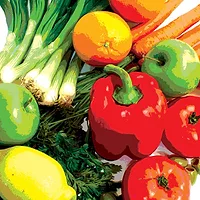Challenges, Progress and Solutions in Produce Safety

Over the past decade, the consumption of fresh fruits and vegetables has increased steadily in the United States.[1] While producers have enjoyed the “fruits” of their success, they also have witnessed a troubling and corresponding rise in microbial foodborne illness incidents associated with raw and minimally processed fruits and vegetables (Figure 1). From 1980 to 1987 and between 1987 to 1995, the number of produce related illnesses more than doubled, spurring produce groups to work with state and federal agricultural and health agencies, consumer groups, and industry trade associations to investigate and develop practices to improve produce safety.[2]

In October 1998, the U.S. Food and Drug Administration’s Center for Food Safety and Applied Nutrition (FDA CFSAN) and the U.S. Department of Agriculture (USDA) jointly issued the Guide to Minimize Microbial Food Safety Hazards for Fresh Fruits and Vegetables to help growers, harvesters, packers and shippers address microbial safety hazards.[3]
The voluntary guidelines provided broad, scientifically based principles to minimize microbial food safety hazards and outlined Good Agricultural Practices (GAPs) and Good Manufacturing Practices (GMPs) for a host of resonating factors that can impact produce safety. Chief among these were land history and surrounding properties, water, manure and biosolids, worker hygiene, field sanitation, packing, cooling, transportation, and traceability. The guide also prompted a lengthy and random list of first-time questions about production practices and safety, including:
• Is water quality suitable for its intended purpose?
• Are wells constructed optimally for water protection?
• Is water source protected from animal contamination?
• Is only properly composted or adequately aged manure used on the fields?
• Are workers knowledgeable and trained in proper hand-washing techniques?
• Are containers and packing material stored in a sanitary manner?
• Are fields located near potentially hazardous sites (landfill) or activities such as livestock or poultry operations?
• Is ice used for cooling made from a potable water source?
• Are proper pest prevention and control measures being used in the packinghouse?
The document was the impetus behind a dramatic shakeup in the produce industry that would both frustrate and prod operations to reach for new heights in product safety.
Not in Kansas Anymore
The landmark guide was well received for its “farm-to-table” protocols. But for many operations, the guide’s risk reduction initiatives were foreign terrain. For the first time, many fruit and vegetable companies faced the difficult challenge of identifying actual and potential food safety hazards within their diverse and distinctive systems. One size does not fit all and the guide’s general principles and risk reduction practices were difficult to apply given the varied geographical conditions in the U.S. (For example, farmers growing lettuce during the summer months in California deal with significantly different factors—soil type, seed varieties, climatic conditions, water sources, irrigation methods, wildlife, pests, and so on—than do lettuce growers who harvest crops during winter in Arizona.)
To worsen matters, many—if not most—operations had to overcome a widespread resistance to change among workers, little or no internal safety training, and the limited ability to assess the level of risk associated with identified hazards. However, the most formidable obstacle, in the minds of many produce operators, was economic.
In the mid-1990s, produce operators were increasingly required by domestic and foreign customers to certify the viability of their safety programs through third-party auditing. Since the certification requests varied on which third-party program to use, it often required a site or operation, which absorbed the auditing costs, to be evaluated more than once by different companies. This redundant process, combined with the actual and perceived cost of implementing GAPs and GMPs (water quality analysis and treatment systems, facility renovations, pest control measures, consulting fees, worker training, etc.), caused some operators to question if it was financially feasible to achieve the guide’s risk reduction goals.
Industry Outreach
Initially, the widespread challenges of implementing the practices and principles to minimize microbial food safety hazards in fresh produce appeared to be overwhelming for operators. Despite bleak forecasts from isolated quarters, the produce industry has recorded significant food safety improvements since the issuance of the guide. Trade associations, such as Western Growers Association, California Strawberry Commission, and United Fresh Fruit and Vegetable Association (UFFVA), were actively involved in the early development of the guide, and through outreach services sponsored informational and training meetings to help its membership apply and implement GAPs and GMPs into their operations.
Looking for quick answers on food safety topics?
Try Ask FSM, our new smart AI search tool.
Ask FSM →
Even while Guide to Minimize Microbial Food Safety Hazards for Fresh Fruits and Vegetables was in development, industry groups were taking a proactive approach to food safety. The California Strawberry Commission developed its own guidance manual on quality assurance practices specific to the Golden State to assist growers and shippers in implementing and managing recommended safety practices.[4] The UFFVA, in partnership with a tri-state consortium comprised of the University of Florida, Texas A&M, and the University of California-Davis, conducted GAP workshops and regional training for operators.
Cornell University, with the assistance of a federal grant, developed Food Safety Begins On The Farm: A Grower’s Guide to aid growers in identifying food safety hazards using FDA/ USDA principles and practices as a model.[5] This guide teaches how to minimize risks before planting, during production, at harvest, and during post-harvest handling by utilizing GAPs. The university, in recognition of the cultural diversity among workers, also developed a bilingual (Spanish) training poster on proper hand washing techniques for agricultural workers.
Overall, the produce industry has an increased awareness of food safety and greater understanding of the guide’s importance in minimizing microbial hazards in produce. A visitor to a farm or packinghouse where management has implemented GAPs and/or GMPs will observe conspicuous evidence of progress. These signs include:
• Strategic placement of rodent traps along packinghouse walls
• Bilingual posters illustrating proper hand washing techniques located next to worker restrooms
• Scarecrows, clad in white coveralls, posted in fields for bird control
• Portable bathroom facilities with hand washing units conveniently placed next to field harvest crews
• Weed-free fields and borders
Handling of produce during harvest can be a possible method or source of contamination through unclean hands or surfaces. Harvest machines and tools have undergone radical changes in the produce world. Significantly more stainless steel and other food-grade materials are now used for food contact surfaces on field equipment and tools. Harvest knives with stainless steel blades and plastic handles are in greater use than the traditional steel blade knife, which easily rusts and has a wood handle that splinters and is difficult to clean. Wooden crates for packing fruits and vegetables to market are rarely seen today; instead, cardboard cartons or returnable plastic containers are used. Bulk bins and containers typically made of wood are being replaced with cleanable plastic or fiberglass.
Equipment sanitation procedures and schedules have been implemented specifically for harvest machines, and many large harvesters and growers now employ trained sanitation crews whose responsibilities include the daily cleaning and sanitation of harvesting equipment, portable toilets/hand washing units, and other tools and machinery prone to microbial growth.
Produce companies are investing in food safety personnel, both internal management and outside consultants, to buoy their safety programs. The addition of qualified individuals committed to the development, implementation and management of food safety initiatives has added tremendously to the success of industry programs. Not surprisingly, a diverse range of new positions, including scientific, technical and quality assurance personnel, have been added at produce companies that did not exist prior to the 1998 publication of the guide.
The use of third-party certification and audits, as well as internal audits, have expanded within the industry, becoming an important tool in helping operators validate the viability of safety programs, identify system breakdowns ranging from process controls to employee training, and meet customer prerequisites.
Value in Strength
From initial, hesitant steps, the produce industry has made significant progress against microbial hazards. The key to the industry’s continued success in this regard lies in building and maintaining prevention plans that properly manage risk reduction practices and being fully cognizant of the “value” of strong and resilient safety programs. In our highly competitive marketplace, the value of well-designed, well-maintained, and well-validated safety programs bears fruit for produce companies in gaining preferred supplier status, in enjoying greater business volume, and in numerous other bottom-line opportunities for growers, harvesters, packers, and shippers.
Still, it is imperative for the produce industry to remove redundant auditing and confusion seen in many certification programs. One promising solution may be Food Marketing Institute’s (FMI) recent purchase of the global Safe Quality Food (SQF) certification program.[6] FMI acquired the program to inform food retailers and wholesalers in the U.S. and around the globe that suppliers who earn the internationally recognized benchmark are committed to providing safe and quality products and adhere to the highest standards of performance. The program is available to all food commodities and designed for use by primary producers and the food manufacturing sector. For the fresh produce industry, UFFVA will serve as the lead partner with FMI. The SQF program may be able to provide what the produce industry needs: a consistent scientific standard across the industry with the retail support and confidence in a single audit system.
Hurdling History
Historically, changes in the produce industry have been met with reluctance and opposition. Five years ago, history appeared ready to repeat itself with the issuance of Guide to Minimize Microbial Food Safety Hazards for Fresh Fruits and Vegetables. With limited knowledge, experience and science serving as barriers, the challenges in identifying actual and potential hazards and in developing risk reduction practices that would actually work were plentiful. In addition, implementation and management of the guide’s recommendations posed their own unique challenges with physical barriers (weather, topography, wildlife), social concerns (diverse workforce), and major economic forces of time, resources and personnel heading a long list of concerns.
The progress recorded in the face of these formidable challenges has been impressive. External forces provided assistance in the form of training workshops and learning tools offered by trade associations and universities. Consultants and food safety professionals were recruited to lend their expertise in the development, implementation and management of effective food safety programs. Operators supplied the resources and leadership to make it all happen. As a result, the produce industry has created a proactive food safety culture.
Frances F. Pabrua is an independent consultant specializing in GAPs and GMPs program development, implementation and management. She was the director of raw product quality and food safety for Fresh Express, where she worked extensively with fruit and vegetable suppliers in the U.S., Canada, and Central America. She also was director of quality assurance for the California Strawberry Commission. Pabrua serves on the Fruit and Vegetable Quality and Safety Professional Development Group of the International Association for Food Protection. She is an active member of the Production and Quality Assurance Council for United Fresh Fruit & Vegetable Association and served as past chair. While at Fresh Express, Pabrua was recognized by the FDA with the CFSAN team award for exceptional performance in developing, planning and conducting the produce farm investigations training course and GAPs train-the-trainer.
John Williams, Jr., is a Senior Communications Specialist with Silliker, Inc., and has written extensively on a wide range of food safety topics.
References
1. Beuchat, L.R. and Ryu, J.H. Produce handling and processing practices. Emerging Infectious Diseases. 3, 459-465. 1997.
2. Gravani, R.B. and E.A. Bihn. Cornell University GAPs Project. 2001.
3. U.S. FDA. Guide to Minimize Microbial Food Safety Hazards for Fresh Fruits and Vegetables. Oct. 1998.
4. California Strawberry Commission. Quality Assurance Program. 1998.
5. Rangarajan, A., et al. Food Safety Begins On The Farm–A Grower’s Guide, Good Agricultural Practices For Fresh Fruits and Vegetables. Cornell University. 2001.
6. Food Marketing Institute. Safe Quality Food Certification Program. 2003.







